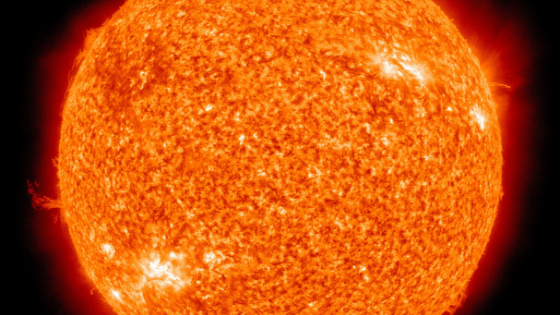What I like about the Question Formulation Technique (QFT) process is that it provides an opportunity for my first graders to ask their questions without feeling insecure or judged on their prior knowledge. The idea that you ask every question that comes to mind when you think of the topic, even if you already know the answer, makes it safe to ask questions that you may think is ‘silly’ or ‘something that everyone else already knows.’ It levels the playing field.
The QFT process also helps me as a teacher to see where some misconceptions are, areas of interest, and what prior knowledge the students have on the topic.
Below, I’ve outlined how I adapted and implemented the QFT in my first-grade class to start a unit on energy.
Designing a Question Focus
For the first QFT I did with my grade 1s I wanted to have a picture, rather than a statement, on energy. My Google search presented me with images that were either too complex/abstract for 6 year olds, or images that were simple and understandable but gave away too much information. Pictures, instead of a statement, can work well sometimes because it is usually more accessible to more students. It eliminates the fact that some students may not be able to read, and although you read it to them at first they need to be able to refer back to it numerous times, it eliminates any language barriers with ELL students, and it helps students activate prior knowledge and make connections easier than a statement would.
However, because I couldn’t find a suitable image for my class I needed to come up with a statement that would be basic enough that all of my students could access it:
QFocus Statement:
The sun gives us energy.
Introducing the QFT: A multi-day process!
As many elementary teachers know, in the earlier grades, students can sustain focus and engagement on one task for about 10-20 minutes at a time (and 20 minutes is pushing it). So instead of going through all the steps in one day, I broke it up over a number of days.
Day 1: Producing Questions
Rather than breaking into small groups, we asked questions as a whole class, because:
- They are grade 1 so their writing skills are limited and very slow. I don’t think they would have been able to get many questions down in a short period of time.
- Their prior-knowledge on energy is limited. By asking questions as a whole class, students could hear other questions that helped spark their own.
- It was the first time this group of students had ever done the QFT. They needed it to be modelled first instead of just walking them through the steps. Doing it as a class allowed me to model the processes, in the hope that the 2nd (or 3rd) inquiry we would eventually do would be more independently done in groups.
Here are the questions that the students asked. I had to stop them at 24 because we ran out of time!
1. How does the sun give you energy?
2. How does it make us run fast?
3. Why does the sun give you energy?
4. What energy does it give you?
5. How does the sun take its energy and give it to us?
6. How does the moon get where the sun was?
7. How does the sun go into you?
8. Why does the sun make us run fast?
9. Does the sun energy expand all over the place and get to everyone in the world?
10. How does the sun give you energy, but the moon doesn’t?
11. Do we waste the sun’s energy? Because it always comes up and stays for a long time.
12. Why Does the sun’s energy only help us and plants? Why can it help anything else?
13. How does the sun get into houses so the lights turn on?
14. How does the sun’s power get into you?
15. What is energy?
16. What does energy do to you when it hits you?
17. What does energy use?
18. What do you do on energy?
19. Who gives you energy?
20. If Gatorade doesn’t give you energy, how do you get energy?
21. Does God give you energy?
22. Could you get burned if the sun hits you?
23. How do they collect energy to put into drinks?
24. How does God give us energy?
You can see the varying information and ideas and interests that students are coming with. They are all drawing on different prior knowledge and experiences of different forms of “energy:”
“How does the sun give you energy”
“Do we waste the sun’s energy? Because it always comes up and stays for a long time.”
“Does God give you energy?”
“How do they collect energy to put into drinks?”
Day 2: Categorizing Questions
On day 2 I did a mini lesson on open and closed questions. We then labelled all of our questions as opened or closed. It was amazing to hear the kids discuss their reasons why they thought it was opened or closed. In the upper grades they do this naturally, but I wasn’t expecting the little guys to do as well as they did.
In the picture you will notice that some questions may be labelled incorrectly, but I wanted to honour their ideas. I was more concerned with encouraging their oral communication and their ability to use reasoning and argument to back up their ideas than making sure the questions were labelled correctly. For the 2nd QFT I would be a little more specific. We did this work on categorization as a whole class.
Day 3: Prioritizing Questions Through Identifying Patterns and Groupings
Prior to day 3 I cut apart all of the questions. In class, we sat in a circle and began to identify common patterns and groups of questions. Each student was given a question. On their turn, they read it out loud to the class. As a class, we discussed what the question was mainly about. If we weren’t sure as to what direction the question was focusing on, the student who originally asked it explained what they meant. Then we decided as a group where it should go. If a category wasn’t created yet for that question we made a new one.
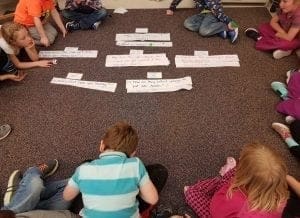
After we placed all of the questions into categories, we then prioritized our top 3 categories (instead of our top 3 individual questions). I decided to do it this way because:
- I anticipated that the little guys would have a hard time picking a question that wasn’t theirs. By choosing categories, many more students’ questions were included in the priority group.
- Grade 1s had some difficulty assessing where a question might take them or where they can go with that question. By focusing on a category instead of a question, I had a little more control over what we learned and what next steps we could take.
- The topic was such an abstract concept, one that has difficult and unfamiliar vocabulary, and one that students have little prior knowledge about. I knew that I would have to go through the research process as a whole class instead of in small groups and so categories would allow us to hit more topics at a time.
We then posted our questions so that we would have easy access to them. And to keep us organized. We ended up with 5 categories: 1. Energy and You 2. Health and Energy 3. Energy in our home 4. The Solar System 5. Energy and God.
As a class, we voted on the top 3 categories. I directed the students to pick the ones they thought were most important and would have the most impact on us.
Top 3 categories:
- The Solar System (of course!)
- Energy and You
- Health and Energy
Day 4 & Beyond: Next Steps
We did many different things to learn about energy.
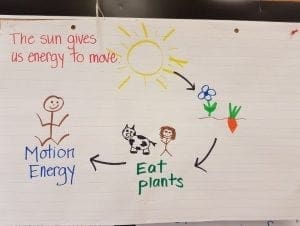
1. Our shared reading focused on energy in our lives. During shared reading we learned how to take notes using pictures.
2. Students brought in books that they had at home for me to read to the class (I didn’t even ask them to, but once one student did, the books came flowing in).
3. Books were displayed in the classroom. Some at reading level, some a little higher. But we
discussed how you can read using pictures. When students learned something new we would add it to our information list. This was posted on the wall by our inquiry questions.
4. We did a couple of experiments, including Marshmallow Launchers and an Air Compressor Experiment. We also used our questions for a code project using makey makeys (we had been learning about coding for the past several months). Through these projects, students demonstrated knowledge and understanding of energy, not through regurgitation, but through creation and explanation.
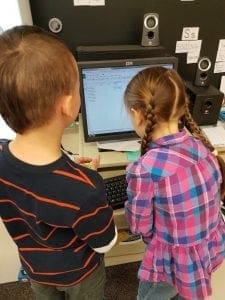
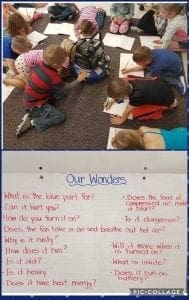
Conclusion
Students who are provided the opportunity to take ownership of their learning, to collaborate with others, and to demonstrate their knowledge and abilities in their own way are not only engaged, but are intrinsically motivated to learn. The QFT allows me to set parameters (based on the curriculum standards I must follow), and at the same time allows students to learn what they are most interested in within those parameters. I also like how the 4 rules automatically ‘level the playing field’ and create an open, accepting environment in which my students feel comfortable sharing.
After we were done the initial steps (asking questions, categorizing them, putting them into groups) I asked my class what they thought of the process. They said:
“I really liked asking questions”
“We came up with a lot of questions all by ourselves!”
“I like we get to learn about our questions.”
I really like using the QFT to start something new. Not only did the QFT help me cover the content outlined in the Ontario Science Curriculum, but also I found a great way to get kids thinking about the topic, to build group collaboration, and to get them interested in what we are learning.
See more like this:
- QFT in the Elementary Classroom: Top 3 Resources
- QFT in the Elementary Classroom: A Collection of Examples
- Explore the Teaching + Learning Resources page for more curated resources.
Jodie Botzang has been teaching for 10 years at the elementary level. As an instructional coach last year, she read Make Just One Change: Teach Students How to Ask Their Own Questions and has been using the Question Formulation Technique ever since. She has used the QFT at many different grade levels, as both an instructional coach and classroom teacher, which gave her opportunities to learn how to adjust the process to work in various situations. She is passionate about instilling curiosity in students and fostering their drive to learn more. You can find Jodie on Twitter @JodieB05.
